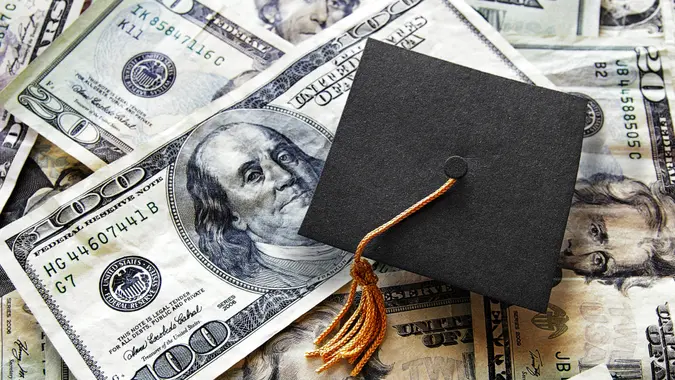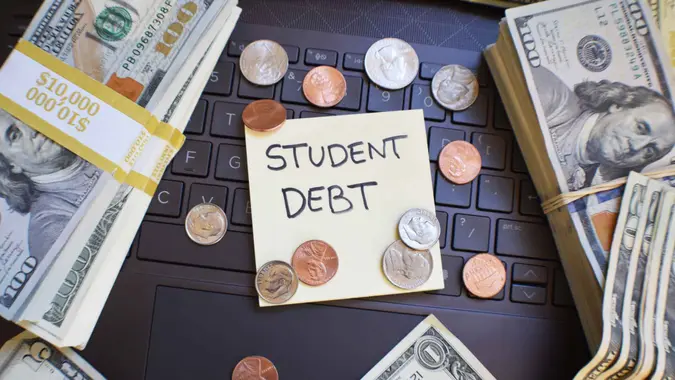Why Americans Can’t Pay Off Their Car Loans — and How You Can Avoid This Struggle

Commitment to Our Readers
GOBankingRates' editorial team is committed to bringing you unbiased reviews and information. We use data-driven methodologies to evaluate financial products and services - our reviews and ratings are not influenced by advertisers. You can read more about our editorial guidelines and our products and services review methodology.

20 Years
Helping You Live Richer

Reviewed
by Experts

Trusted by
Millions of Readers
Inflated car payments are pushing more American households toward the edge of financial catastrophe.
In March, Fortune reported that severe delinquency rates reached their highest level in 17 years. It’s part of a one-two punch fueled by high inflation and the Fed’s action to tame it, coupled with lingering side effects from the pandemic’s impact on the auto industry. The end result is buyers borrowing more money for longer terms at higher rates to get behind the wheel.
Here’s a deeper look into what’s causing this auto loan crisis, and how you can avoid falling into the trap.
There’s Inflation … Then There’s Auto Industry Inflation
In April, Kelly Blue Book reported that the average new car buyer paid under MSRP for the first time in 20 months. Even so, the average price of a new vehicle is still over $48,000 — it was $37,876 before the pandemic.
“Car prices are through the roof,” said Ashley Morgan, a debt and bankruptcy attorney in northern Virginia and founder of Ashley F. Morgan Law.
According to NPR, lingering supply chain problems are part of the reason for such stubbornly high prices, but the industry made a strategic shift that raised MSRPs, too. Since they couldn’t sell as many cars as before, automakers concentrated on the bigger, pricier, higher-end models with the widest profit margins — and it worked so well that they’re in no hurry to go back.
Cars Are Expensive, Unless You’re Financing — Then They’re Really Expensive
In April, Edmunds reported that a record percentage of buyers signed on for monthly car payments of $1,000 or more in the first quarter of 2023. The average monthly payment is now $730, up from $636 in the first quarter of 2022. Nearly 17% of buyers who financed their vehicles committed to four-figure monthly payments.
Those stratospheric numbers became the norm despite the average down payment soaring to a record high of $6,956 — nearly a thousand bucks more than Q1 last year.
Inflated MSRPs are part of the reason that car payments look more like rent payments. But most people borrow to buy, and auto loan rates for new vehicles rose to 7% in the first quarter of 2023, up from 4.4% one year earlier, the highest since 2008 — and that was before the Fed hiked rates for the 10th consecutive time in May.
For Many, More Time Is the Only Path to Affordability
Both the cars and the loans needed to finance them have risen beyond the reach of the average household.
“Car loans are becoming a more significant economic burden due to higher vehicle prices and loan interest rates,” said Laura Adams, MBA, a personal finance expert with Finder.com. “Paying more for a used or new car plus higher interest means larger monthly payments that can squeeze your budget.”
To make it work, many have no choice but to stretch their loans — a move that locks in higher rates for a longer time.
Edmunds states, “More car shoppers are being pushed to the extreme ends of the finance terms spectrum.”
Here’s a snapshot of the Q1 data:
- 36.8% accepted terms of 67-72 months for an average APR of 7.7%
- 30.5% accepted terms of 73-84 months for an average APR of 8.4%
- Just 4.7% locked in the average 2.6% APR that comes with 31- to 36-month terms
“When four- to five-year car loans were average, then you may have a few years without a car loan payment,” said Morgan. “With car loan terms being six, seven, eight years long, car buyers are often needing to buy a new car before the car is even paid off.”
Expensive Car Payments Are Just One of Many Burdens
All of this would be hard enough if it were happening in a vacuum, but car payments are just one of several different forces testing household budgets.
“It is no surprise that more and more Americans are struggling to pay off their car loans,” said Professor Michael Collins, CFA, of Endicott College in Beverly, Massachusetts. “Inflation has been on the rise ever since the post-COVID economic recovery began several years ago, but unfortunately, wages and salaries have not been able to keep up with this cost-of-living increase.”
The result is pressure from every direction.
“Food, gas and rent are all more expensive than last year,” said Morgan. “As a result, everyone’s budget is feeling the squeeze overall, and that rolls over into the car payment, as well.”
Expensive cars, expensive loans and reduced purchasing power make it much harder to buy a vehicle than in years past.
“Fortunately, there are steps that people can take to avoid this situation,” said Collins.
Give the Dealer and the Banker as Little as Possible
If you’re shopping for cars, you should also be shopping for loans.
“It is important to do your research before taking out a loan,” said Collins. “Make sure to find the best deal possible. Shopping around and comparing the different offers from different lenders can help you find the best interest rate.”
Aside from doing your due diligence with research, if you can put off getting a car long enough to scrape together a larger down payment, do so. Rather than upgrading your old junker now, save up for another six months (that is, if the old junker still works). The less loan money you need, the less interest you’ll pay and the better deal you’re likely to get.
More From GOBankingRates
 Written by
Written by  Edited by
Edited by 

























